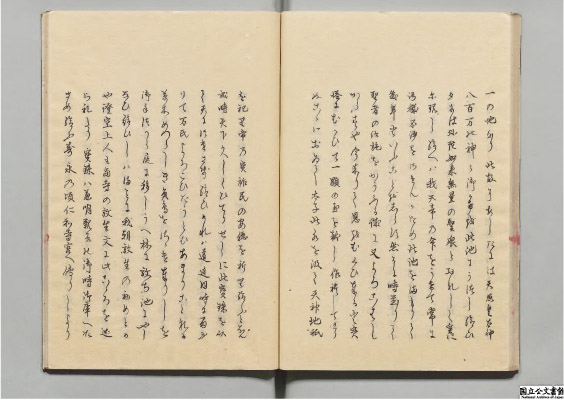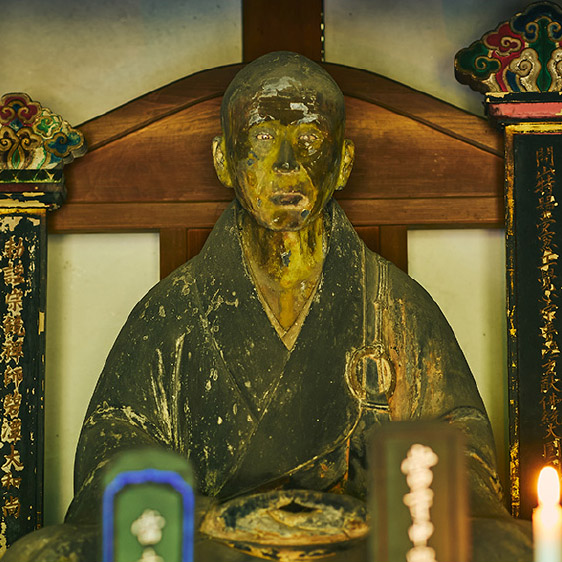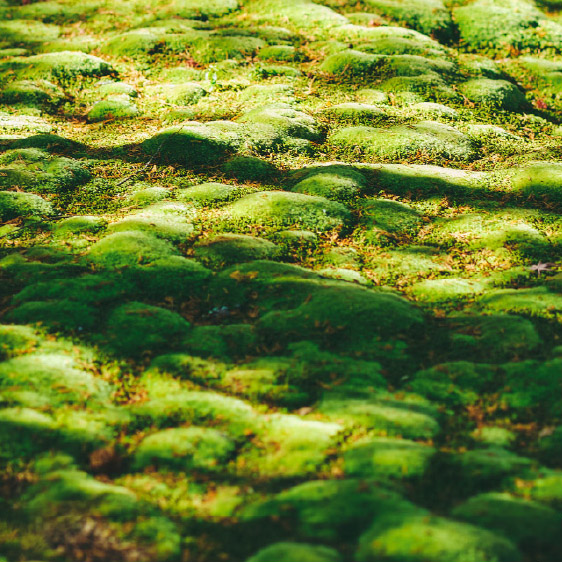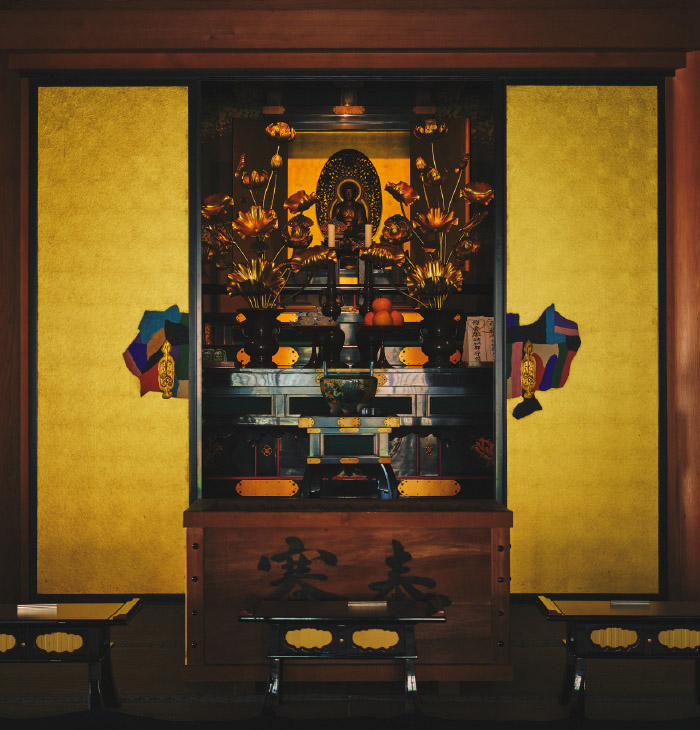about Saihoji
The History of Saihoji
The area where Saihoji currently stands is dotted with burial mounds belonging to the Hata clan, an influential family during Japan’s Kofun Period (250-538) that contributed to the development of Kyoto by introducing advanced technology from China. Prince Shotoku (574-622), a key figure in Japanese history, is also said to have had a villa in the region.
In 731, the Buddhist priest and bodhisattva Gyoki founded Saihoji as a temple within the Hosso Sect of Buddhism. In the early Kamakura Period (1185-1333), Honen Shonin converted the temple to the Jodo Sect of Buddhism, and in 1339, the high priest and master gardener Muso Kokushi restored the then-neglected temple as a Zen temple of the Rinzai Sect.
Many people practiced zazen at Saihoji, including shoguns Yoshimitsu and Yoshimasa of the Ashikaga Dynasty, who modeled the gardens of the famous Golden and Silver Pavilions (Kinkakuji and Ginkakuji) on the gardens at Saihoji.
The temple is converted to the Rinzai Sect of Zen Buddhism
The Founding of the Original Saihoji of the Hosso Sect
During the Nara Period (710-794), Emperor Shomu issued a decree for the founding of 49 temples in the Kinai region of Japan. Famed priest and bodhisattva Gyoki established Saihoji as one of these. At the time, “Saihoji” was written with the characters 西方寺, and the temple would only receive its current characters of 西芳寺 sometime during the Muromachi Period (1336-1573). The latter character reflects more deeply the spirit of Zen. Bodhisattva Gyoki founded Saihoji as a temple of the Hosso Sect of Buddhism, with Amida Nyorai as the main deity and the bodhisattvas Kannon and Seishi as supporting deities. Bodhisattva Gyoki carved the image of the Amida Triad himself, to be worshipped at the new temple.
During the Heian Period (794-1185), Kobo Daishi (also known as Kukai) joined the temple and held a hojo-e ceremony at the Golden Pond on the temple grounds. Hojo-e ceremonies—known as “life release” ceremonies in English—are Buddhist ceremonies in which captive fish, birds, and other living creatures are released in a symbolic rebuke of killing. This event is believed to have been the first hojo-e ceremony to be held in Japan.

—From the History of the Saihoji Ponds and Gardens by Kyukei Chui, Muromachi Period (1400)
Devastation, Revival, and Conversion to the Jodo Sect by Honen Shonin
Saihoji declined over time, but during the Kenkyu Era (1190-1199), the governor of Settsu (a historical province that covers present-day parts of Osaka and Hyogo) Nakahara Morokazu restored the ruined temple and divided it into two parts, Saihoji and Edoji, as he welcomed Honen Shonin, the founder of the Jodo (Pure Land) Sect in Japan. Honen Shonin used gold paint to beautifully decorate the Amida Triad that Bodhisattva Gyoki had enshrined as Saihoji’s principal image. To show respect for his predecessors at the temple, even after it converted to Zen Buddhism, Muso Kokushi kept the Triad as the principal image of Saihoji and it remains as such to this day.
The temple flourished, with Honen Shonin’s disciple Shinran also staying for some time and building the Gutoku-do Hall. During the Shoka Era (1257-1259), Regent of the Shogunate Hojo Tokiyori built the O-do Hall. Following Governor Morokazu’s death, however, the temple once again fell into ruin.
Restoration by Muso Kokushi
The temple was devastated by war, but in 1339, the chief priest of Matsunoo Taisha Shrine, Fujiwara Chikahide, invited high priest and master gardener Muso Kokushi to restore Saihoji as a Zen temple.
Most gardens at the time were built around ponds, but Muso Kokushi introduced a major innovation by arranging the stones to reflect Zen spirituality. Many people, including shoguns Yoshimitsu and Yoshimasa of the Ashikaga Dynasty, visited Saihoji to practice zazen, and the garden is said to have been the model for the quintessential Muromachi Period gardens of the Golden and Silver Pavilions (Kinkakuji and Ginkakuji).

[Did you know? 1]
The Shogun, Ashikaga Yoshimasa, built the Silver Pavilion because he wanted his mother to see Saihoji?
Saihoji’s dry landscape garden, the first of its kind in Japan, fascinated many members of the Japanese nobility when it was first built in the 14th century. Among them, shoguns Yoshimitsu and Yoshimasa visited frequently, and it is said that they modeled the Gold and Silver Pavilions on Saihoji. The garden of the Silver Pavilion in particular followed the design of Saihoji’s garden very closely. One of the reasons was because Yoshimasa wanted to show his mother the beauty of Saihoji, but could not take her there because the temple was closed to women at the time.
Overcoming Natural Disasters and the Flames of War to Be Reborn as the Moss Temple (Koke-Dera)

Saihoji was a favorite of many noblemen and military commanders during the Muromachi Period (1336-1573), but it was unable to escape the flames of the Onin and Bunmei War that raged outside Kyoto from 1467-1477, leading to the temple’s total destruction by fire. Adding salt to the wound, the temple was further damaged by a flood in 1485. Though it was rebuilt with the help of Rennyo Shonin from Honganji Temple, it once again met the terrible fate of being burnt to the ground when the forces of Yanagimoto from Tanba set fire to the valley in an attempt to halt Oda Nobunaga’s advance on Kyoto. The temple only managed to survive because Nobunaga ordered Tenryuji Temple’s Sakugen Shuryo to rebuild Saihoji’s main hall.
During the Edo Period (1603-1867), the Saihoji River overflowed and flooded several times, causing further damage. Trying times continued into the Meiji Period (1868-1912), when movements to abolish Buddhism led to the reduction of the temple’s land. Despite these numerous challenges, the temple managed to survive to the present day due to the valiant efforts of countless supporters, both known and unknown. In 1928, the gardens were opened to the public when the Hankyu Railway Arashiyama Line was opened. The temple is popularly known today as the “Moss Temple” or “Koke-dera” due its famed moss-covered garden. It took more than 100 years for the entire garden to be covered with moss. Somewhat ironically, it was also the history of devastation that allowed for the growth of this moss, leading to the creation of the beautiful temple gardens we can enjoy today.
The Long-Awaited Reconstruction of the Main Hall and Rethinking What It Means to be a Temple

The temple’s main hall of the Sairai-do was burnt to the ground during the Onin and Bunmei War of the 15th century. After a gap of 500 years, it was finally rebuilt in 1969. The fusuma (sliding door) paintings are abstract paintings by the great 20th century artist Domoto Insho. The modern and energetic style of the paintings was a departure from the landscape paintings that had been used for fusuma paintings in temples until then. Just as Muso Kokushi had overturned the conventional wisdom of the garden when he revived and restored the temple, Saihoji’s attitude of fearlessly embracing change is expressed in these fusuma paintings.
The garden is now closed to the general public, but people can visit the garden after pre-making advance reservations and all visitors are requested to copy sutras in the main hall before walking around the garden. This system has been in place since 1977 in order to avoid traffic hazards caused by large numbers of cars and the destruction of the moss in the garden by careless visitors. It has allowed the temple to focus on religious activities appropriate to a Buddhist temple. Unlike many other temples, Saihoji has no particular patron family, so drastically reducing the number of visitors was a difficult decision to take. Nevertheless, the temple made this major change of course in order to preserve the temple and garden and so that visitors can enjoy a peaceful and quiet atmosphere when they visit.
In 2031, Saihoji will celebrate 1,300 years since its founding. It has been loved and supported by many people over the centuries, including the 14th century Shogun Ashikaga Yoshimitsu, famed novelist Kawabata Yasunari, and business visionary Steve Jobs. The temple will continue to take steps to be a source of inspiration and harmony for everyone for many generations to come.
[Did you know? 2]
Japanese Firsts from Saihoji
The dry landscape garden (called karesansui in Japanese) is now considered the quintessential form of the Japanese garden, but it was not always so. The first such garden in Japan is said to have been built in Saihoji by Muso Kokushi during the Muromachi Period (1336-1573). Furthermore, it was at Saihoji that the renowned priest Kukai held the first “life release” (hojo-e) ceremony in Japan, rebuking the killing of animals. Such ceremonies are still held in Buddhist temples today. The temple has always been open to change and innovation, keeping in step with the times through its many centuries of existence, as can be seen even today in the introduction of its visiting policy that requires making reservations in advance. This flexible attitude, fearless of change, may be one of the reasons why it has continued to be loved through the ages.

